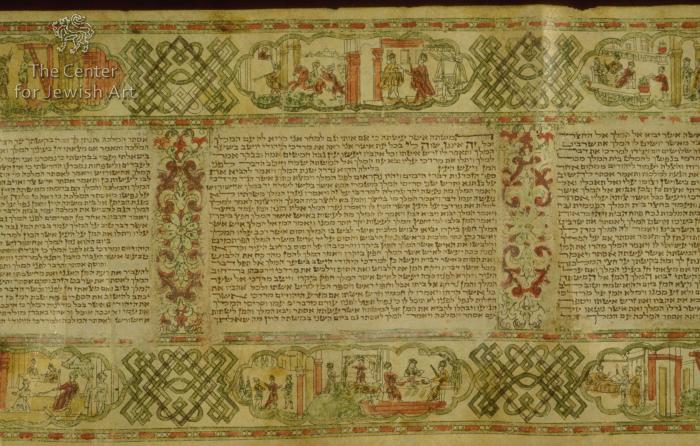Img. ID: 13653

Cartouche 11 (upper margin): On the right, Ahasuerus stands next to his throne and points at Haman who stands before him and they are talking (Es. 6:6-10). On the left, Mordecai rides a horse followed by two men and Haman walks before him while blowing a trumpet (Es. 6:11). The scene of the triumph of Mordecai is supplemented by the depiction of Haman's daughter who, from a window above, throws bed-pan slops on her father's head (T.B. Meg. 16).
Cartouche 12 (lower margin): On the right, the second banquet given by Esther is shown (Es. 7:1). The queen sits at a round laid table and is accompanied by Ahasuerus who sits on the throne topped by a canopy, and by Haman who sits between them. In the central part of the cartouche, Haman is begging for his life and is prostrated on the floor before Esther while Ahasuerus is returning from the palace gardens (Es. 7:7-8). On the left, Ahasuerus stands in the palace garden with a scepter in his hand and is accompanied by two chamberlains; one of them can be Harbonah who suggests hanging Haman on the gallows he had prepared for Mordecai (Es. 7:9).
E | Esther, Book of (following the order of the story) | Mordecai's triumph (Es. 6:11)
E | Esther, Book of (following the order of the story) | Haman's daughter empties a chamber pot on her father's head (Bab. Talmud, Megillah 16a)
E | Esther, Book of (following the order of the story) | Esther's second banquet (Es. 7:1)
E | Esther, Book of (following the order of the story) | Haman begging for his life (Es. 7:8)
E | Esther, Book of (following the order of the story) | Harbona suggests to hang Haman (Es. 7:9)
O | Ornamentation: | Foliate and floral ornaments | Floral motif
O | Ornamentation: | Endless knot
E | Esther, Book of (following the order of the story) | Ahasuerus returns from the palace garden (Es. 7:8)
|
Membranes are stitched together
The name "Gaster I" was introduced by Mendel Metzger in his article entitled "The Earliest Engraved Italian Megilloth" (see "Bibliography"). The type was named after Moses Gaster (1856–1939), the rabbi, scholar, and manuscript collector, who owned a scroll adorned with this pattern (at present this is the scroll Gaster Hebrew MS 710 stored in the John Rylands Library in Manchester). At least 25 manuscripts representing this type are still extant and are preserved in private and institutional collections. For their descriptions see "Related objects".
The pattern features a number of decorative elements common with the scrolls of Klagsbald type.
Bibliography concerning the scroll from the NL:
National Library of Israel (catalogue)
Selected bibliography concerning other scrolls decorated with the same border:
Mendel Metzger, The Earliest Engraved Italian Megilloth, Bulletin of the John Rylands Library 1966, 48/2, 381–432.
Cornelia Bodea, Treasures of Jewish Art. The 1673 Illuminated Scroll of Esther Offered to a Romanian Hierarch, Iaşi–Oxford–Palm Beach–Portland 2002.
A Journey through Jewish Worlds: Highlights from the Braginsky Collection of Hebrew Manuscripts and Printed Books, eds. Evelyn M. Cohen, Emile Schrijver, Sharon Liberman Mintz, Amsterdam 2009, 240-241.
Schöne Seiten. Jüdische Schriftkultur aus der Braginsky Collection, eds. Emile Schrijver, Falk Wiesemann, Evelyn M. Cohen, Sharon Liberman Mintz, Menahem Schmeltzer, Zurich 2011, 262-263.
Dagmara Budzioch, The Decorated Esther Scrolls from the Museum of the Jewish Historical Institute in Warsaw and the Tradition of Megillot Esther Decoration in the Seventeenth and Eighteenth Centuries – An Outline [Polish: Dekorowane zwoje Estery z Żydowskiego Instytutu Historycznego w Warszawie na tle tradycji dekorowania megilot Ester w XVII i XVIII wieku. Zarys problematyki], Warsaw 2019, 1:99-119, 2:64-69.
Dagmara Budzioch, "An Illustrated Scroll of Esther from the Collection of the Jewish Historical Institute as an Example of the Gaster I Megilloth," Kwartalnik Historii Żydów 2013, no. 3 (247), 533–547.



